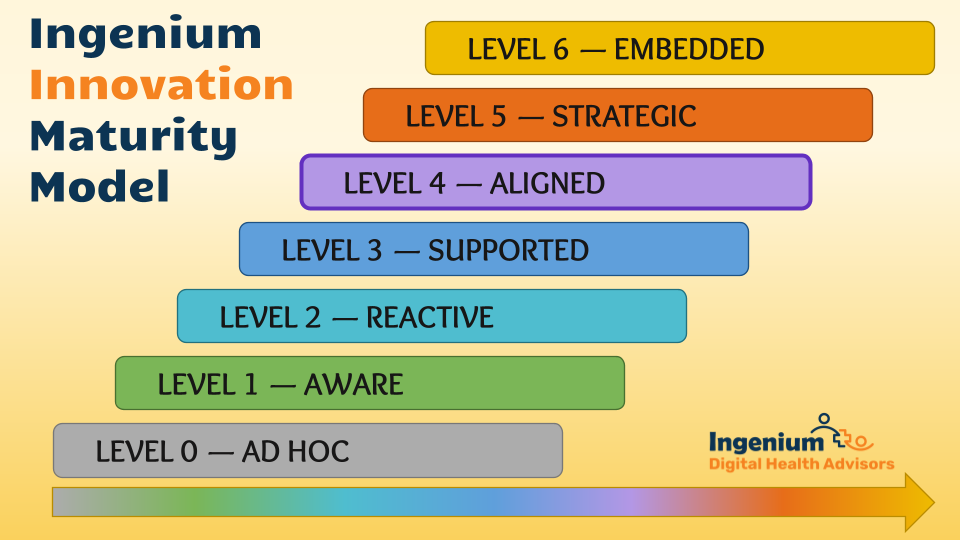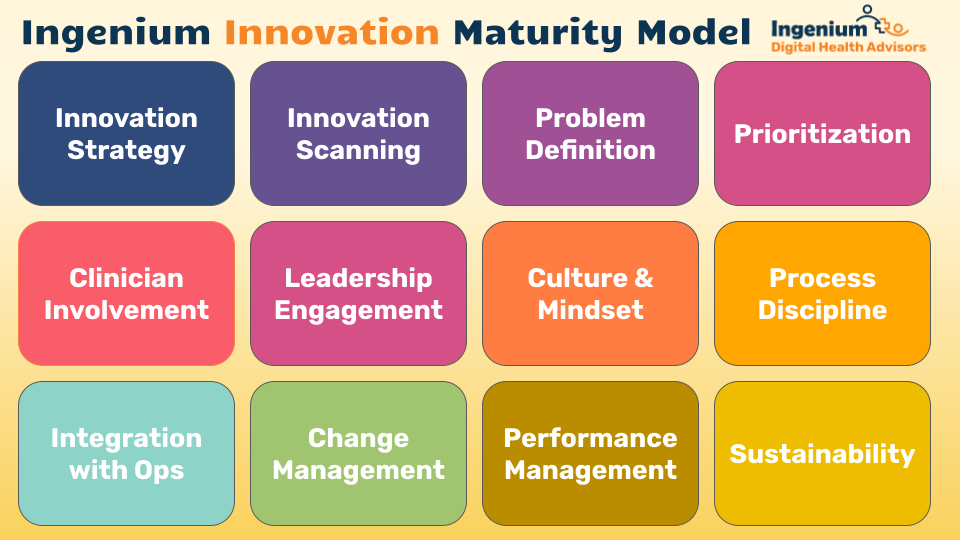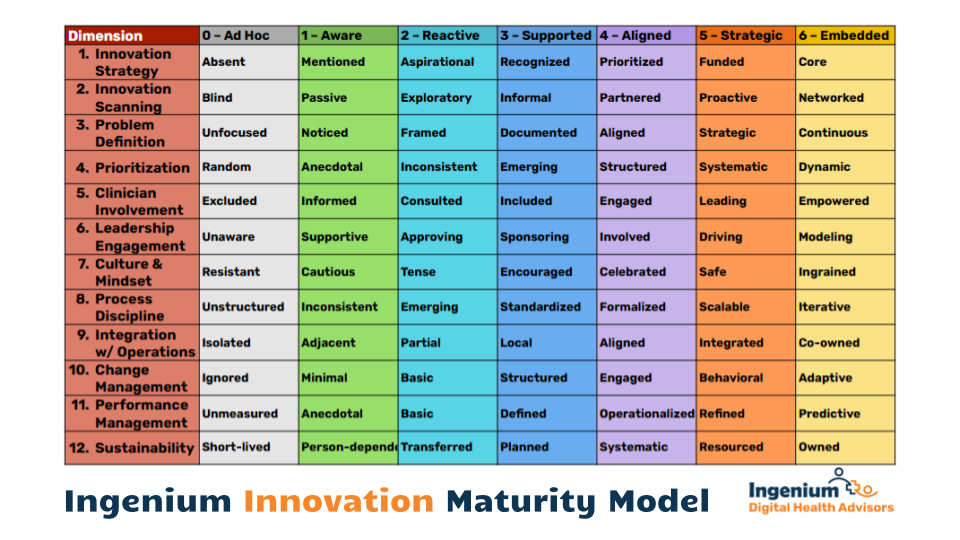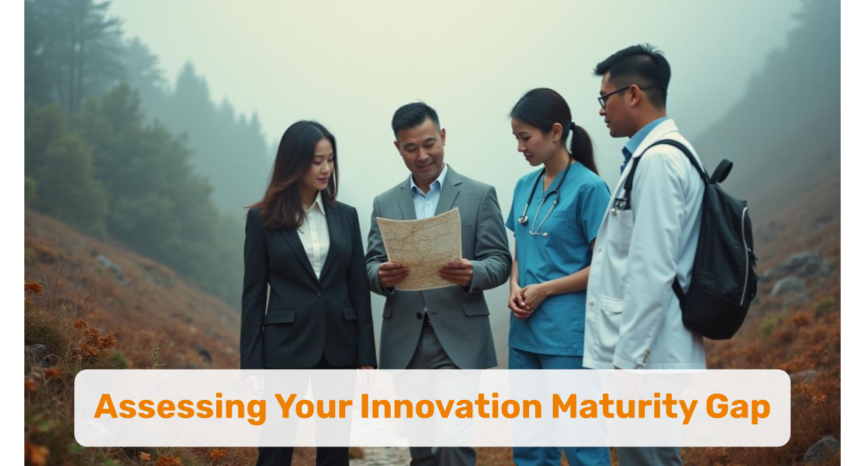This EAI article was written by Christian Milaster, my colleague at Ingenium Healthcare Advisors.
~ ~ ~ ~ ~ ~ ~ ~ ~ ~
“If you don’t know where you’re going, any road will take you there.” — Cheshire Cat
Innovation has never been optional in healthcare.
In fact, we wouldn’t be where we are today in medicine without thousands of innovations — from simple things like handwashing before surgery and involving patients in care decisions to complex T-Cell repairs and robotic surgery.
But just in the last two decades, the pace of innovation creation has exponentially increased, while the pace of innovation adoption has remained stubbornly the same.
The accelerated adoption of innovation is only possible, if leaders consciously create a culture that embraces the creation and adoption of innovation.
The Healthcare Innovation Maturity Model presents a roadmap — guidance on how to slowly build yourself up to become an organization that uses innovation strategically until it becomes embedded in the organization’s DNA.
In today’s article, I’ll share with you how you can assess your organization’s Innovation Maturity.

A Recap: The 7 Levels of Innovation Maturity
The maturity model includes seven levels, representing the different types of innovation cultures at an organization.
Level 0 – Ad hoc: The creation and adoption of innovation is largely absent. If it occurs, it is accidental, isolated, and unsupported. There are rogue innovation efforts of creative disruptors that soon will leave the organization, frustrated. There are no defined goals, processes, or leadership involvement.
Level 1 – Aware: The organization recognizes the value of innovation and may include it in vision statements or leadership talking points. But there is no consistent support structure to act on those intentions. It is good intention with no backing.
Level 2 – Reactive: Innovation efforts are triggered reactively by specific needs or external pressures (e.g., a crisis, a grant opportunity). Projects are pursued on a case-by-case basis, often without coordination or follow-through. It’s more about fixing the crisis than taking advantage of innovation.
Level 3 – Supported: At this level, some structures emerge to enable and support innovation: internal champions are recognized, basic funding is provided for innovation projects, and innovation pilot projects are launched. There is growing leadership support, but innovation is still not fully aligned with strategic goals.
Level 4 – Aligned: At this level, innovation efforts are clearly tied to organizational priorities. Processes exist for identifying and managing initiatives. There is coordination across departments, and innovation is integrated into planning and budgeting cycles. This is the initial target level for most organizations we help to improve their organizational innovation maturity.
Level 5 – Strategic: Here, innovation is purposefully applied to the achievement of virtually every strategic goal. Innovation is encouraged and rewarded and is led by dedicated teams and governed by strategic priorities. Resources, roles, and processes are in place to support not just experimentation, but adoption, scaling, and sustainability.
Level 6 – Embedded: Innovation is now a defining organizational capability, part of the DNA. Innovation principles to solve problems are integrated into daily operations, supported by data, and driven by a culture that rewards curiosity, learning, and continuous improvement. Everyone — leaders, clinicians, staff — is empowered and rewarded to innovate.

Assessing Your Maturity across the 12 Dimensions
As I referenced above, the primary utility of a maturity model lies in its ability to help you figure out where you are, determine where you want to go, and then chart a course of training and improvement to get where you want to be.
To do so, the first step is knowing where you stand.
This is where the 7 levels of maturity for each of the 12 dimensions come into play: For each of the 12 aspects of maturity, we have identified 7 levels that you can use to assess where your organization falls.
This exercise, which should take 20-30 minutes, is best done as a group – reaching consensus on where people think the organization falls (for the most part).
In this exercise, the discussion about different viewpoints is actually even more important as the decision where to put the “dot”.
(for a more detailed discussions of the 12 dimensions, consult my prior article)
1. Innovation Strategy: How clearly innovation is defined, resourced, and aligned with strategic priorities.
- 0: Absent — No focus or vision on innovation.
- 1: Mentioned — Innovation is occasionally referenced but not acted on.
- 2: Aspirational — Appears in plans but lacks structure, resources, or follow-through.
- 3: Recognized — Programs or leaders are beginning to support innovation efforts.
- 4: Prioritized — Innovation goals are aligned to enterprise strategy and reviewed.
- 5: Funded — Innovation is a strategic pillar with clear KPIs and governance.
- 6: Core — Innovation is a continuous, integrated, and identity-defining function.
2. Innovation Scanning: How actively the organization identifies and explores external innovation opportunities.
- 0: Blind — No scanning or awareness of emerging ideas or technologies.
- 1: Passive — Exposure is limited to occasional events or vendor pitches.
- 2: Exploratory — Some leaders independently explore trends or tools.
- 3: Informal — Teams share and test ideas, but without structure.
- 4: Partnered — Innovation is brought in through pilots or external partnerships.
- 5: Proactive — Dedicated roles or processes exist for scouting.
- 6: Networked — The organization is embedded in an external innovation ecosystem.
3. Problem Definition: How clearly and systematically the organization identifies what’s worth solving.
- 0: Unfocused — No process to define or prioritize problems.
- 1: Noticed — Issues surface informally or reactively.
- 2: Framed — Problem statements exist but vary in quality.
- 3: Documented — Key pain points are consistently mapped.
- 4: Aligned — Innovation efforts are tied to well-defined problems.
- 5: Strategic — Problems are prioritized based on strategic impact.
- 6: Continuous — Feedback loops surface evolving needs in real time.
4. Prioritization: How decisions are made about which innovations to pursue.
- 0: Random — Decisions are made ad hoc, with no criteria.
- 1: Anecdotal — Ideas are selected based on visibility or urgency.
- 2: Inconsistent — Criteria exist but are not consistently applied.
- 3: Emerging — Pilots are reviewed using a developing framework.
- 4: Structured — Prioritization follows defined impact/feasibility filters.
- 5: Systematic — All initiatives pass through a formal evaluation funnel.
- 6: Dynamic — Priorities are continuously adjusted using real-time data.
5. Clinician Involvement: How meaningfully clinicians are engaged in innovation design and decisions.
- 0: Excluded — Clinicians are not involved.
- 1: Informed — Clinicians are told, but not asked.
- 2: Consulted — Input is solicited sporadically.
- 3: Included — Clinicians co-design some solutions.
- 4: Engaged — Clinicians serve in advisory or governance roles.
- 5: Leading — Clinicians co-lead innovation initiatives.
- 6: Empowered — Clinicians identify, design, and champion innovation at scale.
6. Leadership Engagement: How visibly and actively leaders support innovation.
- 0: Unaware — Innovation is not on the leadership agenda.
- 1: Supportive — Leaders acknowledge innovation but stay hands-off.
- 2: Approving — Leaders sign off on efforts but do not engage.
- 3: Sponsoring — Leaders champion specific projects or people.
- 4: Involved — Leaders review progress and remove barriers.
- 5: Driving — Leadership sets direction and invests strategically.
- 6: Modeling — Innovation is embedded in leadership behaviors and decisions.
7. Culture & Mindset: The beliefs and behaviors that shape how innovation is embraced.
- 0: Resistant — Change is avoided or punished.
- 1: Cautious — Early adopters are tolerated but not supported.
- 2: Tense — Innovation is seen as risky or extra work.
- 3: Encouraged — Creativity is supported in some pockets.
- 4: Celebrated — Innovation is recognized and rewarded.
- 5: Safe — Experimentation and learning from failure are expected.
- 6: Ingrained — Innovation is a cultural norm across all teams.
8. Process Discipline: The consistency of processes for testing, scaling, and sustaining innovation.
- 0: Unstructured — Every project starts from scratch.
- 1: Inconsistent — Some templates or tools exist, but they’re optional.
- 2: Emerging — Teams are building repeatable methods.
- 3: Standardized — Clear steps and tools guide implementation.
- 4: Formalized — Playbooks, training, and reviews are in place.
- 5: Scalable — Processes support cross-org scaling.
- 6: Iterative — Continuous improvement is embedded in the process.
9. Integration with Operations: How well innovation efforts are connected to day-to-day workflows.
- 0: Isolated — Pilots are siloed and disconnected from reality.
- 1: Adjacent — Innovations happen near but not within core operations.
- 2: Partial — Some adoption, but limited integration.
- 3: Local — Ops teams participate at the department level.
- 4: Aligned — Ops is involved early in planning.
- 5: Integrated — Ops and innovation are jointly planned.
- 6: Co-owned — Ops and innovation teams design, deploy, and manage together.
10. Change Management: How the organization supports people through change.
- 0: Ignored — There is no plan to manage change.
- 1: Minimal — Communication is reactive and inconsistent.
- 2: Basic — Some training and messaging accompany rollouts.
- 3: Structured — Change plans are created for major projects.
- 4: Engaged — Change leaders are part of the design process.
- 5: Behavioral — Change strategies are guided by behavioral science.
- 6: Adaptive — Change approaches evolve based on feedback and data.
11. Performance Management: How innovation outcomes are measured and used to inform decisions.
- 0: Unmeasured — No data is collected.
- 1: Anecdotal — Success is shared through stories.
- 2: Basic — Some metrics are tracked after implementation.
- 3: Defined — KPIs are set and reviewed.
- 4: Operationalized — Dashboards are used by leadership and teams.
- 5: Refined — Metrics guide iterative improvements.
- 6: Predictive — Data drives forecasting, prioritization, and investments.
12. Sustainability: Whether innovations last—and evolve.
- 0: Short-lived — Projects fade after launch.
- 1: Person-dependent — Survival depends on a champion.
- 2: Transferred — Handoffs occur but lack ownership.
- 3: Planned — Sustainability is considered at the start.
- 4: Systematic — Structures are in place for long-term support.
- 5: Resourced — Ongoing funding and roles are dedicated.
- 6: Owned — Innovations are maintained, evaluated, and evolved over time.

Real innovation isn’t about chasing the next big thing.
It’s about building the capacity to consistently solve what matters.

If you’d like to receive these Inspirations in your inbox every other week, you can subscribe to Kathy’s Excellence Advantage Inspirations Newsletter.
Kathy Letendre, President and Founder of Letendre & Associates, advises organizations and leaders to create their excellence advantage.
Contact Kathy by phone or text at 802-779-4315 or via email.

